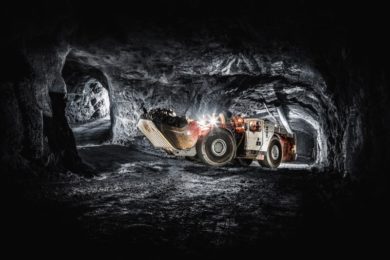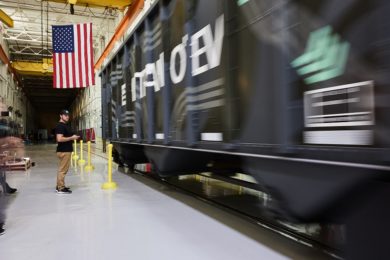The Oyu Tolgoi gold and copper mine in Mongolia has positioned itself as a leader in autonomous operation by rolling out the Sandvik AutoMine® system for its underground operations. Co-owned and operated by the Rio Tinto subsidiary Turquoise Hill Resources, the mine sits on one of the world’s largest copper and gold deposits in the southern part of the Gobi Desert. With undercutting of the block cave now underway, two Sandvik LH514 loaders have been commissioned and will operate autonomously using Sandvik AutoMine®.
Senior Production Manager at Oyu Tolgoi, Andy Curtis, says the implementation of AutoMine® technology promises to optimise production by increasing utilisation and improving safety. “The project will enable us to conduct the mucking of the undercut ore throughout the shift change period when no one is underground due to blasting,” he says. “We can reduce the amount of interaction between heavy mining equipment and personnel during the course of the shift as well as allowing the business to be more productive.”
Chief Advisor for Underground Technology at Rio Tinto, Danie Burger, adds: “Sandvik has long been a trusted automation partner for Rio Tinto at our underground operations. As Oyu Tolgoi enters its underground operations phase, the use of AutoMine® consolidates the mine’s position as one of the most modern, safe and sustainable operations in the world.”
The Oyu Tolgoi mine is jointly owned by the government of Mongolia, which has 34% ownership, and Turquoise Hill Resources, which owns 66%. Rio Tinto owns 50.8% of Turquoise Hill Resources and manages the operation on behalf of the owners.
Open pit mining began on site in 2011 and the operation’s copper concentrator – the largest industrial complex ever built in Mongolia – began processing mined ore into copper concentrate in 2013. However, the bulk of the ore is to be extracted extracted from the underground reserves through the mining method known as block caving. In January this year, the Oyu Tolgoi Board gave the green light for underground operations to begin and sustainable underground production is expected in the first half of 2023. Some 90 km of tunnels have built over 11 years to enable ore extraction.
The roll-out of AutoMine® underground represents the first time automation technology has been implemented in any part of the Oyu Tolgoi operation. The efficient extraction of gold and copper from the mine will also have flow-on sustainability benefits.
President of the Digital Mining Technologies Division at Sandvik Mining & Rock Solutions, Riku Pulli, praised the cooperation that enabled AutoMine® to be commissioned despite global travel restrictions due to COVID-19: “It is absolutely great to see what has been achieved with the close teamwork between Rio Tinto/Oyu Tolgoi and Sandvik on our joint mission to maximise Oyu Tolgoi’s safety and productivity,” he says.
He added: “The fact that the AutoMine system installation and commissioning was performed so well with no overseas travels is a big credit especially to the local team at the mine site in Mongolia. I am looking forward to seeing how the use of digital and automation technologies will expand at Oyu Tolgoi as the production levels continue ramping up.”
The AutoMine® system will allow the Sandvik loaders to be remotely monitored and operated from a control room on the surface. Operators typically only need to assume control of the loaders at the loading point, with the rest of the load and dump cycle undertaken autonomously.
Andy Curtis says the implementation of full autonomous technology will support employment. “The process still requires operator support for loading the bucket of the machine, although the operator will be positioned at a remote operating station on the surface during this shift change automation period,” he says. “The introduction of new high technology requires maintenance and technology support and is therefore creating opportunities and increasing the skill level of the maintenance work force.”










